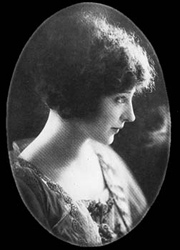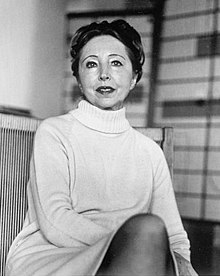Anaïs Nin

This article needs additional citations for verification. (December 2007) |
Anaïs Nin IPA: [ana'iːs nin] (born Angela Anais Juana Antolina Rosa Edelmira Nin y Culmell) (February 21 1903 - January 14 1977) was a French-born author who became famous for her published journals, which span more than 60 years, beginning when she was 11 years old and ending shortly before her death. Nin is also famous for her erotica, which not only is sensual, but also acts as a study of sexuality in its perfection and flaws.
Her first husband was Hugh Parker Guiler, a banker and artist, whom she married as a young woman in March 1923. Rupert Pole, whom she married in 1955 while still married to Guiler, was a forester and the step-grandson of architect Frank Lloyd Wright. After the death of Hugh Guiler in 1985, the unexpurgated versions of her journals were commissioned by Pole.[1]
Biography
Anaïs Nin was born in Neuilly, France to two artistic parents. Her father, Joaquin Nin, was a Cuban[2][3] pianist and composer, and her mother Rosa Culmell[4] was also Cuban,[5] but of French and Danish ancestry and was a classically trained singer. Her paternal great-grandfather fled France during the Revolution, going first to Haiti, then New Orleans, and finally to Cuba where he helped build that country's first railroad.[6] After her parents separated, her mother moved Anaïs and her two brothers, Thorvald Nin and Joaquin Nin-Culmell from Barcelona to New York City. According to her diaries, Volume One, 1931 - 1934, Nin abandoned formal schooling at the age of 16 and began working as a model.
On 3 March 1923, in Havana, Cuba, she married Guiler aka Ian Hugo (1898-1985) the name he used when he became a filmmaker of experimental films in the late 1940s. The couple moved to Paris the following year, where Guiler pursued his banking career and Nin began to pursue her interest in writing. Her first published work was a critical evaluation of D. H. Lawrence called D. H. Lawrence: An Unprofessional Study. She also explored the field of psychotherapy, studying under the likes of Otto Rank, a disciple of Sigmund Freud. According to her diaries,Volume One, 1931 - 1934, Nin shared a Bohemian lifestyle with Henry Miller during that time in Paris. There is no mention of her husband in that edited edition. In 1939, Nin and Hugh Parker Guiler moved back to New York City. Nin appeared in the Kenneth Anger film Inauguration of the Pleasure Dome (1954) as Astarte, the Maya Deren film Ritual in Transfigured Time (1946), and in Bells of Atlantis (1952), a film directed by Guiler under the name "Ian Hugo" with a soundtrack of electronic music by Louis and Bebe Barron.
She entered into a second marriage to Rupert Pole, which took place in Quartzsite, Arizona on 17 March 1955, before she and Pole returned to live in California.[7] Guiler remained in New York City and was unaware of Nin's second marriage until after her death in 1977. She often cited authors Djuna Barnes and D. H. Lawrence as inspirations. She states in Volume One of her diaries that she and Henry Miller drew inspiration from Marcel Proust, André Gide, Jean Cocteau, Paul Valéry, and Arthur Rimbaud.
Journals
Anaïs Nin is perhaps best remembered as a diarist. Her journals, which span several decades, provide a deeply explorative insight into her personal life and relationships. Nin was acquainted, often quite intimately, with a number of prominent authors, artists, and psychoanalysts and other prominent figures. Her journals portray these persons in a profound depth of analysis and frankness of description. Moreover, as a female author describing a primarily masculine constellation of celebrities, Nin's journals have acquired importance as a counterbalancing perspective.
Erotic writings

Nin is hailed by many critics as one of the finest writers of female erotica. She was one of the first women to really explore the realm of erotic writing, and certainly the first prominent woman in modern Europe to write erotica. Before her, erotica written by women was very infrequent except for a few writers such as Kate Chopin.
According to Volume I of her diaries, 1931 - 1934, published in 1966 (Stuhlmann), Nin first came across erotica when her mother and two brothers returned to Paris in her late teens. They rented the apartment of an American man who was going away for the summer, and Nin came across a number of French paperbacks: "One by one, I read these books, which were completely new to me. I had never read erotic literature in America… They overwhelmed me. I was innocent before I read them, but by the time I had read them all, there was nothing I did not know about sexual exploits… I had my degree in erotic lore."
Faced with a desperate need for money, Nin and Miller began in the 1940s to write erotic and pornographic narratives for an anonymous "collector" for a dollar a page, somewhat as a joke.[8] Nin considered the characters in her erotica to be extreme caricatures and never intended the work to be published, but changed her mind in the early 1970s and allowed them to be published as Delta of Venus and Little Birds.
Nin was a friend, and in some cases lover, of many leading literary figures, including Henry Miller, Antonin Artaud, Edmund Wilson, Gore Vidal, James Agee, and Lawrence Durrell. Her passionate love affair and friendship with Miller strongly influenced her both as a woman and an author. An apocryphal rumor abounds that Nin was bisexual, promulgated by the Philip Kaufman film, Henry & June. Although this rumor is widely believed to be false, Nin's journals leave many questions about her relationship with June Miller, Henry Miller's wife. In her unexpurgated journals, she wrote that she had an incestuous relationship with her father, and she refers to experiments with bisexuality, and sexual relationships and experiences with women.
Later life and legacy
In 1973 she received an honorary doctorate from the Philadelphia College of Art. She was elected to the United States National Institute of Arts and Letters in 1974. She died in Los Angeles, California on January 14 1977; her body was cremated, and her ashes were scattered over Santa Monica Bay. Rupert Pole was named Nin's literary executor, and he arranged to have new unexpurgated editions of Nin's books and diaries published between 1985 and his death in 2006.
In 1990 Philip Kaufman directed the film Henry & June based on Nin's novel Henry & June from The Journal of Love – The Unexpurgated Diary of Anaïs Nin, 1931-1932.
Quotes
- "Life shrinks or expands in proportion to one's courage."
- "We don't see things as they are, we see things as we are."
- "This diary is my kief, hashish, and opium pipe. This is my drug and my vice."
- "...for no one has ever loved an adventurous woman as they have loved adventurous men."
- "And the day came when the risk to remain tight in a bud was more painful than the risk it took to blossom."
- "Love never dies a natural death. It dies because we don't know how to replenish its source. It dies of blindness and errors and betrayals. It dies of illness and wounds; it dies of weariness, of withering, of tarnishing."
List of works
- D.H. Lawrence: An Unprofessional Study
- Collages
- Winter of Artifice
- Under a Glass Bell
- House of Incest
- Delta of Venus
- Little Birds
- Cities of the Interior, in five volumes:
- The Diary of Anaïs Nin 7 volumes
- The Early Diary of Anaïs Nin 4 volumes
- The Novel of the Future
- In Favor of the Sensitive Man
- Henry and June
- Incest
- Fire
- Nearer the Moon
Notes
- ^ http://www.latimes.com/news/obituaries/la-me-pole26jul26,0,7114784.story?coll=la-home-headlines
- ^ [1] "Her Cuban father was a celebrated pianist and composer"
- ^ [2] "Joaquin Nin, a prominent Cuban pianist and composer"
- ^ [3]
- ^ <http://www.morbidoutlook.com/nonfiction/articles/2001_03_anaisnin.html"
- ^ Diaries, Volume 1, 1931 - 1934
- ^ Bair biography, 1995 and IMDB.
- ^ http://www.geocities.com/arsenio_grilo/a_nin_1.html
References
- Deirdre Bair, Anaïs Nin: A Biography (New York: Putnam, 1995) ISBN 0-399-13988-5
